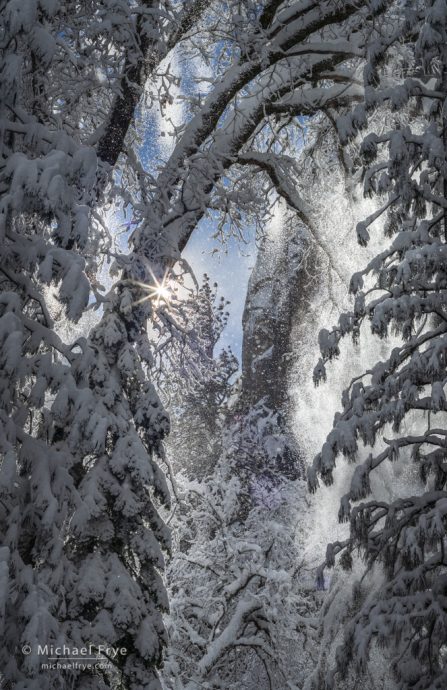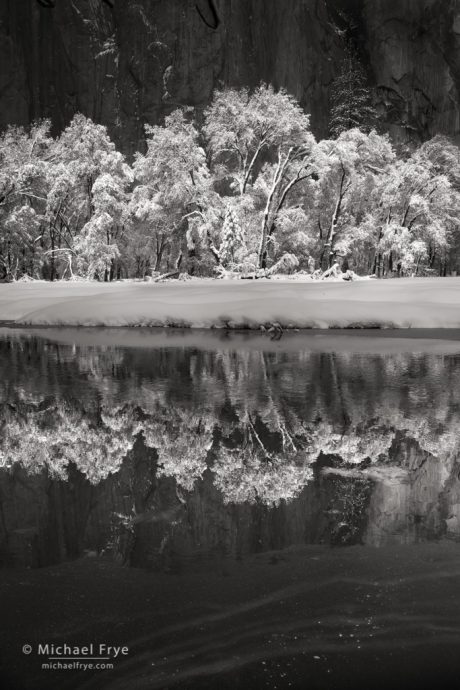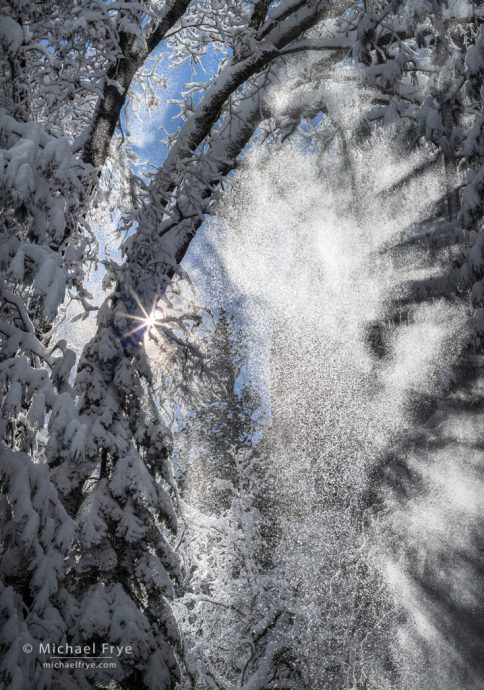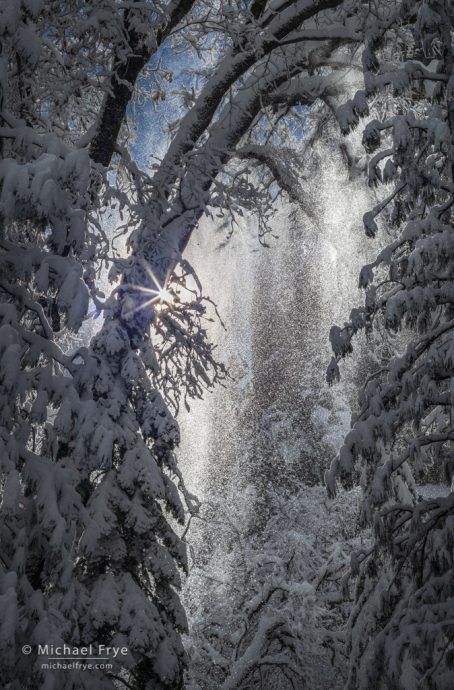On that snowy day I wrote about in my previous post the sun came out quickly, so our first stop was a spot near El Capitan that was still in the shade. I was looking for reflections, but then the sun hit the oaks across the river, while a cloud threw shade over El Cap, creating a beautiful contrast between the bright white trees and the dark cliff behind them.
The snowbank below the oaks, however, was really bright and distracting. All I need, I thought, is for a cloud to shade that snowbank while the sun was still hitting the trees. And a minute later it happened, setting up a dark-light-dark-light pattern. (That’s the image at the top of this post.)
Sometime later we started walking back to the car, but didn’t get very far. The sun had reached a small patch of trees, and snow started to rain down from the branches. The backlit, falling snow looked striking, so I had to stop.
It was a very challenging situation to photograph. It was hard to even compose the picture since the scene was so contrasty, and I had to keep moving and re-composing to keep the sun partially hidden behind a tree trunk. I’d wait for some snow to fall, fire off a series of frames, and then move again, since the sun would be swinging out from behind the trunk and creating lens flare. So I’d step to the left, recompose, wait for more snow to fall, shoot a series of frames, step left again… and so on.
But I forced myself to make this effort because it was such a beautiful scene. The snow kept falling in unpredictable patterns, and there was no way to know in advance which moment would turn out to be the best. So I tried to capture as many frames as possible, and hope that some of them worked.
I use this same approach whenever I’m photographing repetitive movement, like waves, wind, cascading water, and so on. Even animals repeat their movements sometimes. I’m not just firing the shutter randomly; I’m picking moments that seem promising, then making a series of exposures in order to capture one image that rises above the rest. With cascading water I’ll often take 20 or more frames with the same composition and settings, looking for one image with just the right water motion.
Photographing the snow falling from the trees the other day I made 195 exposures. And I wasn’t bracketing, because bracketing doesn’t work when you’re trying to capture such scenes. First, it’s difficult to blend exposures when things are moving. Second, if the idea is not to blend, but to hedge your bets and make sure you don’t miss the exposure, then the frame that captured the perfect moment is likely to be under- or over-exposed. It’s better to just get the exposure right without bracketing. (And it helps, with a high-contrast scene like this, to use a camera with good dynamic range.)
I had to throw out many of those 195 frames because they had excessive lens flare, or because the falling snow just wasn’t very interesting at that moment. And I missed a lot of good moments while moving and recomposing. But fortunately I managed to capture a few good moments as well. Here are three, just to show the variety of movement.

Snow falling from trees #1, Yosemite. (All three of these images were captured at 1/750th of a second at f/16, ISO 100.)
At the bottom of this post you’ll also find a short video Claudia and I made about that snowy day. It’s been really fun seeing the Yosemite Valley with so much snow.
— Michael Frye
Related Posts: Snow in Yosemite Valley; A Monster Storm
Michael Frye is a professional photographer specializing in landscapes and nature. He is the author or principal photographer of The Photographer’s Guide to Yosemite, Yosemite Meditations, Yosemite Meditations for Women, Yosemite Meditations for Adventurers, and Digital Landscape Photography: In the Footsteps of Ansel Adams and the Great Masters. He has also written three eBooks: Light & Land: Landscapes in the Digital Darkroom, Exposure for Outdoor Photography, and Landscapes in Lightroom: The Essential Step-by-Step Guide. Michael has written numerous magazine articles on the art and technique of photography, and his images have been published in over thirty countries around the world. Michael has lived either in or near Yosemite National Park since 1983, currently residing just outside the park in Mariposa, California.












Great post, once again!
Thanks Claude!
Truly a wish I had been there post :-). Just magical.
The info on how you approach those is really helpful.
Thanks as always, and nice video finishing it off. Did Claudia shoot it with an iPhone? Or something bigger?
Thanks Doug! She used her iPhone.
Stunningly beautiful images. Your stills of the falling snow are quite good, but I have to say that the video was awesome! Having lived in northern NY for many years (now in NC), the sounds and images of snow falling from trees is striking. I’m sure you experience it in Yosemite, as I have in NY. Sometimes it is so quiet during a snow storm that one can hear the snow falling – the soft gentle sound of the flakes landing. Thank you for bringing these memories back to me.
Thanks Martin, and I’m glad you liked the video!
Wow the video was really cool! I like the #2 of snowfall from trees. You are so lucky to live nearby! Thanks for sharing what we cannot witness.
Thank you Karl!
Thanks, Michael, beautiful images and like the other said, the video was fantastic. How wonderful to see Yosemite after a big snowfall! The snow falling from the trees take me back to the days when I lived in Truckee and we’d ski in the woods after a snowfall.
Thanks Bob! There’s nothing like fresh snow.
Wow, realy cool. Thanks.
Thank you Jacopo!
So beautiful, my husband and I love looking at your images. We adore Yosemite and your pictures bring back many special memories of our travels when we’ve been over from England. X
Thanks Elizabeth, and I’m glad this brought back some good memories!
Michael, I will probably never make it to Yosemite under such snowy conditions, so it is wonderful to see it through your eyes. Thanks for the virtual trip.
Glad you enjoyed this Hadley!
Soooo pretty. Thanks for explaining your approach to making the shots. I learn something from every post.
Thanks Gina!
Absolutely breathtaking, Michael! I dream of snowfalls like that.
Best, Vivienne
Thank you Vivienne! Snow is beautiful. Well, it can be beautiful – when it’s new and fresh.
True. Our snow, what’s left of it, looks terrible now.
Very nice Michael, as always. We’ve been here in Yosemite for over a week now and enjoyed shooting the wide variety of conditions. We think winter is the best season here.
Thanks Dave. I love winter too.
Beautiful photos Michael with the added pleasure of seeing you make them in the excellent atmospheric video. It’s been 20 years since I last visited Yosemite but you bring back great memories. Thanks from Ireland!
Thanks Luke!
Michael, those are wonderful and extremely creative. Thank you for again helping me think outside the box. Being creative is always a challenge for some of us.
BTW, I did finally make it into the park this past Wednesday and Thursday after two previously failed attempts due to the severe weather. I am so happy to have finally gotten to see and photograph the current conditions. 🙂
Thanks very much John. I’m glad you got to see some of the snow!
Really enjoyed this series of Snow in Yosemite. The Snow Covered Oaks looks almost like an infrared image, spectacular. The video is captivating, watched it many times.
Thank you Dave – glad you liked the video!